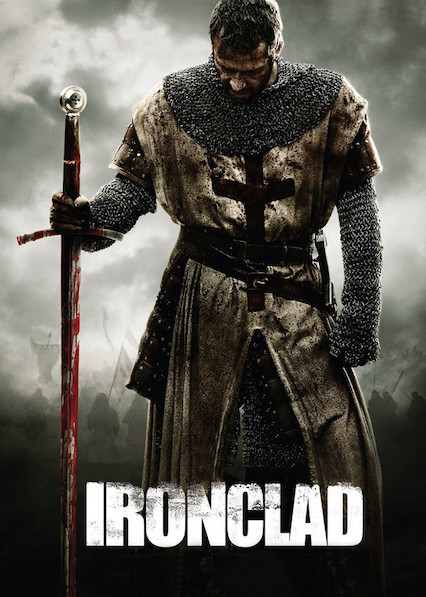 This film represents the Middle Ages through many historical references. The first being the Magna Carta, which in the beginning of the movie sets the context for the film. Magna Carta, meaning "Great Charter" was created in 1215 CE by the English barons who revolted and defeated against him. Historian Judith Bennett describes the document stating that the "Magna Carta sought to keep the king within the bounds of popular and feudal custom" (Bennett 254). King John, as detailed in the film, went on to challenge this document. Beyond King John and the Magna Carta, this film also represents the Medieval Times through the Knights Templar, portraying the God-fearing main character as dedicated, yet conflicted. Finally, Ironclad portrays the Lord society of the Middle Ages, as at the Castle of Rochester the local Lord has leadership over the peasant society living there.
This film represents the Middle Ages through many historical references. The first being the Magna Carta, which in the beginning of the movie sets the context for the film. Magna Carta, meaning "Great Charter" was created in 1215 CE by the English barons who revolted and defeated against him. Historian Judith Bennett describes the document stating that the "Magna Carta sought to keep the king within the bounds of popular and feudal custom" (Bennett 254). King John, as detailed in the film, went on to challenge this document. Beyond King John and the Magna Carta, this film also represents the Medieval Times through the Knights Templar, portraying the God-fearing main character as dedicated, yet conflicted. Finally, Ironclad portrays the Lord society of the Middle Ages, as at the Castle of Rochester the local Lord has leadership over the peasant society living there.Like nearly all Medieval films, Ironclad is a mixture of historical accuracy and social misrepresentation through the implementation of present day stereotypes. The film accurately portrays the links between the relationship between King John, the English citizens, and conflict at the time, as well as making historical connections between the Knights Templar and the Crusades. However, there is various common misconceptions throughout the film. One would be the dark and "brown" settings, portraying the Medieval world as disease ridden and rotten. In 1215, when this film takes place, the Middle Ages were actually going through their greatest time period of innovation as the 12th Century Renaissance was blooming. Another stereotype was that of the Rochester Castle setting, in which a greedy Lord ruled, however all the citizens were peasants in the midst of no farm land nor merchant trade. By 1215, England was deeply ingrained in agriculture with new inventions like the heavy plow and horse collar, however the estate in Ironclad had no resources, and even demonstrated a food shortage, which would have been very unlikely for the time. Despite these few inaccuracies the film is overall impressive in its representation of historical context and battle, including an array of medieval weapons, armor, and chivalry.
 |
| King John as depicted in Ironclad |
The only historical inaccuracies observed in the film was King John's relationship with the papacy and the King John's views on the divine right. In Ironclad, King John claims to have the support of the Pope, however Mark Cartwright of Ancient History Encyclopedia states that "the Pope ordered the closure of all churches in England and excommunicated John in 1209 CE" (Cartwright). King John also decrees the "divine right" in this film, however the idea that the King was to rule because it was meant to be from God did not emerge until several centuries after the Middle Ages. Despite this, the majority of the film accurately depicts history through a violently entertaining illustration. Ironclad features many battle scenes filled with action and gore, demonstrating Medieval battle tactics and weaponry. In this "David vs. Goliath" film the small ragtag revolution group sets the tone for a King against the people storyline. Ironclad creates the common Medieval story of the people taking a stand against oppression.
Ironclad (2011) presents a story of oppression, revolt, and even romance involving a conflicted Templar. Through this film a story is observable that brings historical context and popular culture to a fusion. As one can get caught up in the seemingly endless action and battle, Ironclad presents a respectable Medieval portrayal that both entertains and teaches.
Sources:
Cartwright, Mark. Magna Carta. Ancient History Encyclopedia, 20 November 2018, https://www.ancient.eu/Magna_Carta/.
Bennett, Judith M. Medieval Europe: A Short History. New York, McGraw Hill, 2011.
Ironclad. Directed by Jonathan English, Warner Brothers and ARC Entertainment, 2011.



I like the in text cite back to the class book and how well you cut through the misinformation from the movie.
ReplyDeleteI like the back story you gave in order to set up for what is going on in the film. Really informative for a viewer who might want to watch this film. Seems like based on the other reviews I've read on this movie that it focuses heavily on violence and gore. Do you think that is because of the idea everyone has on the Middle Ages? Or is it just for entertainment purposes for people?
ReplyDeleteI like all the connections you made between the movie and the lectures from class! I thought it was especially interesting how you tied in the 12th century renaissance to dispel some of the myths about food shortages or medieval inventions. While the movie seems to rely heavily on violence and gore, it does sound like it has some redeemable qualities as it does a decent job of telling the story of King John and the Magna Carta. Great job!
ReplyDelete